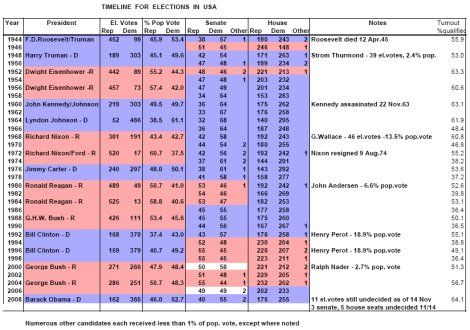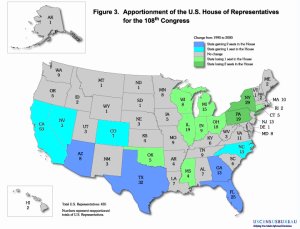 |
HISTORY OF U.S.A. ELECTIONS Comparison with other Democracies |
Bill Biega's Essays |
|
Click on any illustration with colored border to see it full size. Then click on "Back" button to return to this page. U.S. ELECTIONS, Presidential and Congressional - 1944 to 2008The 2008 national elections in the United States aroused enormous interest, not only in the country, but also world-wide. This writer searched for a concise comparison with other elections since World War II and was unable to find one. Therefore I put together the following tabulation: (click on it to enlarge): The unique U.S. political systemA quick glance at the tabulation reveals that a Republican president has been in power for 36 years, just over half the time. However, the Democrats have reigned in the House for 48, and in the Senate for 44 of those 64 years. How many of you knew that?
In the elections of 1948, 1960, 1968, 1992, 1996, 2000, the President-elect was selected with less than 50% of the votes cast. In the hotly contested
election of 2000, the loser, Al Gore, actually received more of the votes cast than George Bush! This occurs because of the unique situation in the United States, in which voters do not actually vote directly for president. Instead they vote for delegates to the Electoral College, which in turn elects the President. In 48 of the states (and the District of Columbia) all the state's Electors cast their votes for the candidate who received the majority of the popular votes in that state.
Surprise! Richard Nixon is widely considered to have been an unpopular President. Note, however, that for his second term, he received the largest majority both of popular vote and Electoral votes of any other candidate in the 64 years! Too bad that he got himself involved in the Watergate conspiracy, and facing impeachment resigned. In the United States, the Senate has a very large influence on the policies of the nation. It must approve all legislation, and confirm all appointments of the President to major executive positions in the government, and of judges in the Supreme Court and Appeals courts. It must also confirm any treaties with foreign countries or agencies. For example, the United State never joined the League of Nations after World War I because the Senate refused consent. The Constitution established that each state has two members in the Senate, the voters in states with smaller populations (such as Alaska or Montana) exercise a much stronger relative influence on national policies than those in populous states (such as New York or California).
Unless the party of the President has at least 60 Senators, the opposition party can delay legislation endlessly. If the Senate is evenly split, as was the case from 1950 to 1958, and again 2000-2002 and 2006-2008, very little is accomplished.
A weakness of the United States government is the stipulation in the Constitution that Representatives to the House are re-elected every two years. This results in many decisions being made with a short term view to please the voters supporting a given Member at the next election, just a few months away.
Another negative effect of the present American political system is the enormous amount of time and money spent on the election process. The primary and final election campaigns in the 2008 presidential election lasted a year and a half and reportedly cost about one billion dollars! Therefore only very rich people, or ones with the strong backing of various political and commercial organizations, can afford to run for office. Comparison with other democratic nations In most other democracies, the Head of State, whether a monarch or elected President, serves a more ceremonial role than in the U.S.A. The Prime Minister, usually the leader of the party with strongest electoral support, is the head of government. Therefore the head of government and parliamentary support are from the same political party. This leads to much faster decisions. NOTE The table is in printable form. Please use it for reference, take it to the office or school, use as a basis for discussions. Return to top of page |
|
||||||||||||||||||||||
| ||||||||||||||||||||||||
| ||||||||||||||||||||||||



